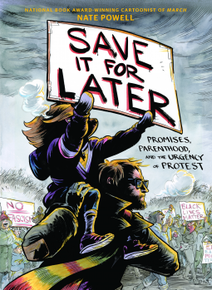
This collection of graphic essays presents Nate Powell as he tackles with the election of 2016, difficult conversations he has with his young daughter on the power of protest and symbols (especially those used by white supremacists), and the effect of the Global Pandemic on his family and his mental state. In early chapters, Powell recounts telling his children about then-candidate Trump (although not specifically named until the end of the book). As white supremacy becomes a more visible component of American society, Powell reflects on writing March with John Lewis and Andrew Aydin, and trying to reconcile those protest movements with the marches by Neo Nazis through his city and state. In the last chapter, Powell has a call-to-arms where he challenges others not to passively agree with others who are protesting, but to do some of it for yourself as well.
The comic essay may be an area that hasn't been explored much by students and school libraries, and you may not have many in the collection. We are used to our comics being for entertainment, not to serve as a vehicle for opinion. Powell has won several awards for his illustrations, so it seems natural for him to grapple with these difficult topics through comic format. He warns up front that this is not a manual for parenting, although there is quite a bit of reflection and explanation on how he talked with his daughter. In one of the chapters, Powell follows the progression of white supremacy - from Nazis in WWII, to beards being symbols of paramilitary, to monochromatic black cars, to the use of the Punisher logo, to the black-and-white version of the American Flag, to Mohawks being adopted by American fascists - and a lot of it relies on probably a deeper understanding of recent American history than I possess. This chapter broke with the more personal reflections Powell had in every other chapter, and thus stood out of place a bit amidst the others, but provides interesting insight into the foundations of the conversations Powell has with his family, and even with strangers while protesting.
Powell's award-winning skills as an illustrated are on full display here. The review copy wasn't fully colored on every page as the final published work will be, but what was colored was done so expertly. On every page, the fear and uncertainty plaguing the country comes through in dark illustrations with heavy use of bold shading and thick lines. Colors are muted and fade often as the conversation turns to bleaker topics. The glimmers of hope that Powell's daughter bring also brings in more color, but the loss of color around her shows her loss of faith and her fear growing as the pandemic sets in. Rather than sticking to one design choice, Powell uses color like another character in the book, constantly conveying emotion. Once again, the suitability level is based not on the inappropriateness of the content (although there are a few F-bombs), but rather in the reader having a passing understanding of American History and national politics. This would pair well with an American History, Government, or Civics curriculum. Sara's Rating: 8/10 Suitability Level: Grades 11-12 This review was made possible with an advanced reader copy from the publisher through Net Galley. Publisher: Abrams ComicArts Publication Date: April 6, 2021 ISBN: 9781419749124 (Hardcover) Tags: Rating: 8/10, Suitability: High School, Graphic Nonfiction, Memoir, Family, Abrams ComicsArts
0 Comments
Leave a Reply. |
About MeI've been reading manga and comicbooks for years. Now, I write reviews and other helpful things for School Librarians, teachers, parents, and students. Search this siteRatings, Audience, and Subject Tags
All
Archives
July 2024
|




